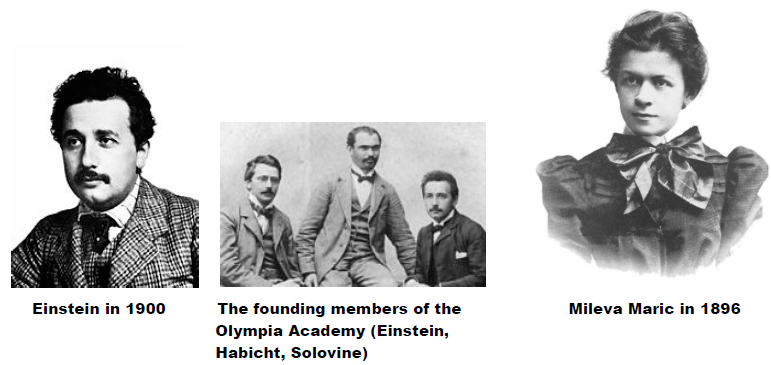| RESOURCE MATERIAL for the EINSTEIN CENTENARY (2015) |  |
|
PITP/ST-JOHNS PUBLIC LECTURES, 2014 -2015 |
|
Albert Einstein: the Man, the Science, and the Philosophy Einstein is the most famous scientist to have ever lived - indeed, according to a number of surveys carried out by newspapers at the end of the last millennium, he is one of the most famous people in human history. Even now, 60 yrs after his death, he still features occasionally on the cover of Time magazine (as he did on quite a few occasions during his lifetime). He was nominated as the "Man of the 19th century" by Time magazine (in 1922); and again as the "Man of the 20th century", again by Time magazine, in Dec 1999. Much more remarkably, in 3 different surveys of readers published on Dec 31sth, 1999, Einstein was nominated by readers in France (in "Le Monde"), in the UK (in the "London Times"), and in Canada (in the "Globe and Mail") as the most important person of the last 1000 yrs. It seems that the editors of both the London Times and of the Globe and Mail were unhappy with this result! More recently, UNESCO proclaimed 2005 to be the 'international Einstein year', to celebrate Einstein's celebrated publications of 1905; and so it goes on. So what explains this remarkable view of a man whose work was, and still is, completely incomprehensible to almost everyone in the world? In what follows we take a peek at his life, and unravel at least some of his remarkable story (this is only a brief intro - for more on some of the topics discussed below, go to the here). |
|
 |
||
|
Years before 1919: Einstein lived from 1879-1955, a time that saw huge changes in Europe. Born in Ulm in March 1879, his family lived in Germany until he was 15, at which point they moved to Italy - at the age of 16 he enrolled in the Swiss Federal Polytechnic in Zurich (now the well-known Eidgenossische Technische Hochschule or ETH). Einstein did not do all that well there, and after finishing in 1900 was not able to get the kind of job as a teacher that he wanted - after nearly 2 years, and with the help of his friend Marcel Grossmann's father, he finally got a job at the Swiss patent office in Bern. By 1903 he was married to his first wife, Mileva Maric, who had also studied physics in Zurich. With a group of friends Einstein formed a group called the "Olympia Academy", which mostly discussed questions of philosophy and physics - ranging widely over writers as varied as Kant, Spinoza, and Hume (Kant having been of interest to Einstein for many years), Mach and Poincare, and a variety of literary figures. The picture one has here of Einstein is of someone intensely interested in a large variety of intellectual questions, who absorbed ideas and then used them to develop his own ideas in a very independent way - self-study was the key here, and he pursued a very idiosyncratic path through the byways of European ideas of the time, all the while focussing on his own attempts to do physics research. He had not particularly liked school (indeed, later made it clear how much he had despised the regimented German high school system), but already as a teenager had worried intensely about key questions in science and philosophy. By 1903 he had a steady job, but he was almost unknown to the wider scientific world, although he had published a few papers. |
||
|
All this changed in the "annus mirabilis" of 1905, when he published a series of papers which (i) introduced the light quantum (later called the photon) and used the idea to explain the photoelectric effect (ii) gave an early theory of statistical mechanics, following on ideas of Maxwell and Boltzmann, and used it to explain Brownian motion, and (iii) introduced his theory of Special Relativity, which reconciled electromagnetism theory with the ordinary dynamics of particles, at the same time changing our whole notion of time and simultaneity; and used it to predict the famous relationship between mass and energy (ie., E = mc2). By the standards of the day these papers were not extraordinary in their mathematical sophistication (but nor were they simple either); but in the depth and daring of their physical insight they were radical indeed. It is a tribute to the open character of the physics research community of that time that Einstein's ideas did not take long to be recognized. In particular Max Planck, the foremost theoretical physicist in Germany at that time, strongly backed him, and by 1908 Einstein (to the astonishment of his boss at the patent office) was awarded a lecturer position in the University of Bern. From 1909-1914, he occupied a succession of professorships in Zurich and Prague, at the same time making key contributions to a whole variety of different topics in physics - many of these would only bear fruit much later (such as his work on what is now called quantum optics, which led many years later to the invention of the laser, amongst many other things). His contributions ranged from the early quantum theory, electromagnetism and optics, solid-state physics, and relativity to fluid mechanics and mechanical and electrical engineering (he never lost his interest in, and talent for, down-to earth problems in science). In 1914 he moved to Berlin to take up a prestigious chair at the Kaiser-Wilhelm institute, along with a position at the university, largely liberated from teaching duties. In 1916-18 he was even president of the German physical society. Incredibly, in 11 short years Einstein had gone from complete obscurity to become the most famous theoretical physicist in the world - and he was now apparently the establishment figure par excellence. Appearances were, however, misleading. Quite apart from the disintegration of his marriage in 1914 (he and Mileva Maric separated in 1914, and he had already begun an affair with his future 2nd wife Elsa Lowenthal in 1912), and his anti-war political activities in the period 1914-18, Einstein found himself increasingly locked in the scientific struggle of his life, in an effort to find the theory of gravitation - he later characterized the period from 1908-1915 as follows: "The years of anxious searching in the dark, with their intense longing, their intense alternations of confidence and exhaustion and the final emergence into the light - only those who have experienced it can understand it." In Nov 1915, after many reversals, he finally found success, in the form of his General Theory of Relativity - this, along with Newton's "Principia Mathematica", is the most incredible single piece of work in the history of science. The effort was so enormous that Einstein was ill for most of the following 6 months, and his excitement so great, on realizing that he had found the right theory, that he suffered heart palpitations at the time. Only a handful of people at the time recognized the enormity of what he had done - amongst whom deSitter, Weyl, Lorentz, Schwarzchild, Reissner & Nordstrom, Thirring, and Eddington - but Einstein himself was in no doubt; in a letter to his son Hans Albert in he wrote:
Like Newton's work, it will take centuries for Einstein's theory to show us its full power - but already in the first 4 years after its discovery, other theorists had realized that they now had in their hands a theory of the entire universe, and they were not slow to develop its consequences. Incredibly, for the first few years the only empirical support for the theory was in the form of the perihelion precession of Mercury - a very small change in the orbital motion of the planet, discovered many years earlier, which could not be explained by Newtonian mechanics. But such was the stature of Einstein that theorists simply took his ideas on trust. Years of Fame (1919-1939): Einstein first became known to the general public around the world in 1919, when the British solar eclipse expedition, having sent teams to both Principe and Sobral in the tropics, came back with what turned out to be strong evidence for the validity of Einstein's General Theory of Relativity. This expedition had been organized by Eddington and Dyson, in effort to see the very small deflection of light around the sun predicted by Einstein's theory, coming from the 'bending of spacetime' caused by the solar mass. In a highly dramatic meeting at the headquarters of the Royal Society in London, the cream of the British astrophysics and physics establishment (in the persons of A Eddington, F Dyson, and JJ Thompson) electrified their audience with the announcement of the results. The scene was described by AN Whitehead at the time: "The whole atmosphere of tense interest was exactly that of the Greek drama: we were the chorus commenting on the decree of destiny as disclosed in the development of a supreme incident. There was dramatic quality in the very staging: the traditional ceremonial, and in the background the picture of Newton to remind us that the greatest of scientific generalizations was now, after more than two centuries, to receive its first modification. Nor was the personal interest wanting: a great adventure in thought had at last come safe to shore.... The laws of physics are the decrees of fate." The president of the Royal Society, JJ Thompson, described the theory which had led to the expedition, as "one of the most momentous, if not the most momentous, pronouncements of human thought." The Times of London duly reported this meeting in suitably dramatic terms - and the fact that Einstein was at the time a Swiss-German, who had been notable in the 1st World War for having not joined in the mass chauvinism and war-mongering prevalent in both Germany and Britain during the war, further heightened the interest in Britain. Within days the news that 'Newton had been overthrown', and that new notion of space, time, and the universe were in the air, had been widely publicized in North America and continental Europe (although in a much more muted way in Germany). The Times of London even asked Einstein to write an article in English for its readers, a request to which he duly responded, writing at the end of this article: "Note: Some of the statements in your paper concerning my life and person owe their origin to the lively imagination of the writer. Here is yet another application of the principle of relativity for the delectation of the reader: today I am described in Germany as a "German savant," and in England as a "Swiss Jew." Should it ever be my fate to be represented as a bete noire, I should, on the contrary, become a "Swiss Jew" for the Germans and a "German savant" for the English" |
||
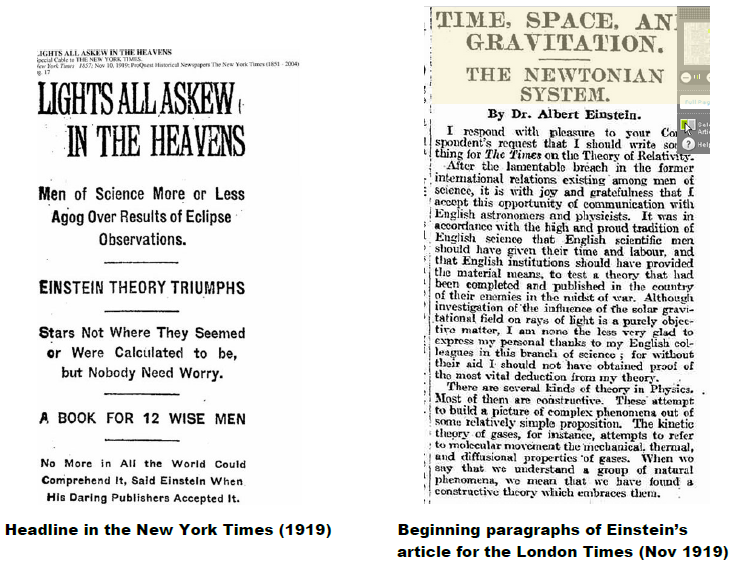 |
||
| From these days in Nov 1919 onwards, Einstein became a rather dramatic public figure. Journalists and politicians alike began to discover the iconoclastic man behind the established icon of science, capable of deploying humour and irony at will. In 1921-22 he undertook a world tour, visiting the UK, the US, various Asian countries, and returning via Palestine. In the course of this tour he gave lectures to both scientific societies and the general public, along with many interviews, wherein the public began to discover his views on a huge variety of topics. This did not affect his scientific reputation - he was already the world's leading physicist in the eyes of his scientific peers, even if he cut a slightly unusual figure amongst them. | ||
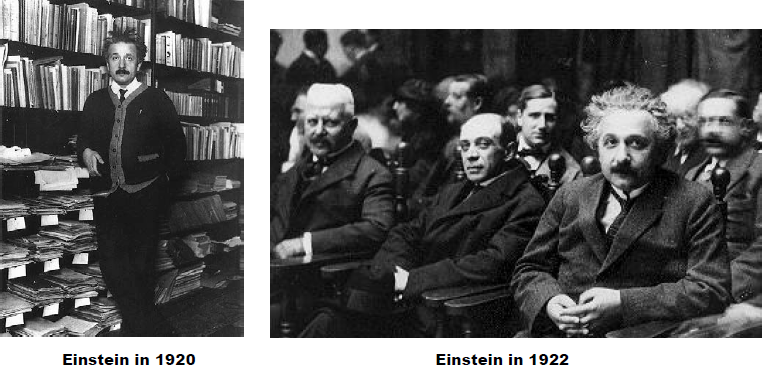 |
||
| During the period from 1908-1925 Einstein played an increasingly important role in the development of almost all important branches of physics, and his unique scientific style (a blend of deep philosophical reflection, abstruse mathematics, daring speculation, and a very down-to earth understanding of the real world) had an enormous influence, persisting to this day. It was a revolutionary time for science - and in the heady atmosphere of cafes in Vienna, Berlin, Paris and Copenhagen, along with the more staid atmosphere of universities from Cambridge to Moscow, physics absorbed the lessons of relativity and the quantum, and prepared to make the huge leap to quantum mechanics. And Einstein was at the centre of this revolution, the touchstone for many of the physicists around him. | ||
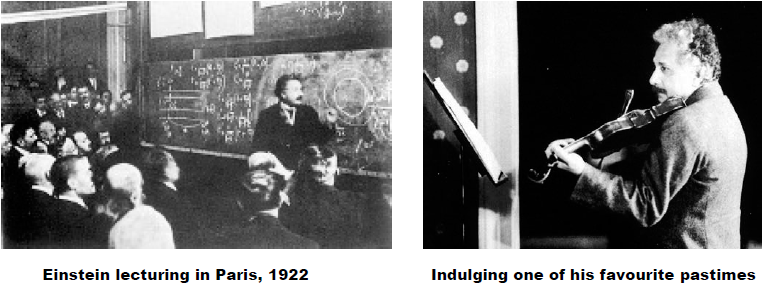 |
||
| However enormous political movements were also in gathering force, which only a few years after the discovery of quantum mechanics (in the period 1925-26) were to take Einstein away from Europe, to the USA. The contrast between the huge welcome he received in the US, the informal lifestyle there, and his vilification by the Nazi press back in Germany, made a deep impression on Einstein - he finally emigrated in 1933. | ||
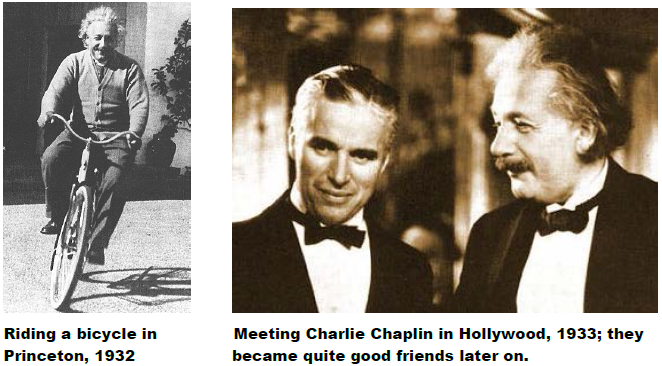 |
||
For the rest of the 1930's Einstein alternated in his scientific work between extending the ideas of the General Theory (notably in his work on gravitational waves with Infeld), and combating the ideas that had been laid down in the 'Copenhagen interpretation' of Quantum Mechanics (most notably in the famous "Einstein-Podolsky-Rosen" or "EPR" paper of 1935). His views on quantum mechanics were completely at odds with those of the Copenhagen school, led by Bohr, and it was these latter views that prevailed at that time. Essentially Einstein felt that the statistical character of quantum mechanics reflected an inadequacy of the theory, and after the 1935 EPR paper, he no longer attempted to contribute to the theory. He correctly perceived that there was a deep divide between the physics embodied in the General Theory of Relativity and that in quantum mechanics, and he maintained to the end of his life a view of 'physical realism' very much opposed to the prevailing view of quantum mechanics. During the same period Einstein also expounded in much more detail his ever-changing ideas on science, philosophy, psychology, and even religion, to an audience ranging from scientists to the lay public. Einstein's views on epistemology were of considerable interest - they reflected his early interest in Kant, but revised to take account of his own work - and his views on the primitive elements that make up human thought and language were very original. His views on religion attracted much more interest, both because of his rejection of organized religion and because of his attachment to the Jewish cause (although he rejected the dogmas of Jewish religion in the same way as he rejected all others). Einstein's ideas were also of increasing interest to the FBI, which by his death had compiled a 3500-page dossier on him. The interest of the FBI was ironic - Einstein was very vocal in his defense of anti-totalitarian political and moral ideals, ideals that were as unwelcome to the US right wing as they were to the Nazis. But in many quarters around the world, his political and moral views began to earn him enormous respect. During most of the 1920's and the early 1930's, Einstein had promoted a fairly strong pacifist viewpoint - but the rize of fascism and the outbreak of war led him to revise this view. After the war (see below) he returned to a more pacifist view, and these views became very widely known. Post 1939: the Grand Old Man: When the 2nd world war came, Einstein was kept well away from all US war activities, being considered a security risk - his only important role was to sign the famous letter to FD Roosevelt that initiated the Manhattan atomic bomb project (drafted by Wigner and Szilard), but he was quite unaware of what happened thereafter (the idea at the time was to make a bomb before the Nazis succeeded). Einstein's reaction when the bomb was exploded in Aug 1945 in Japan is well known - he was extremely distressed. |
||
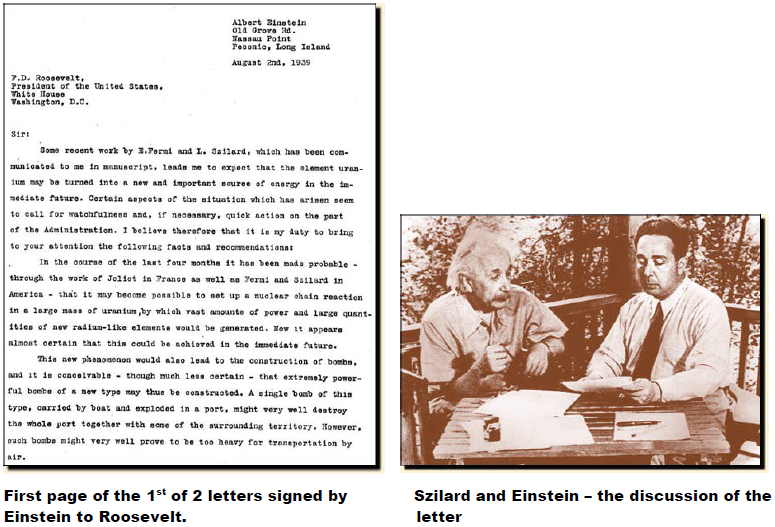 |
||
| Curiously, two of the great myths propagated by US newspapers after the war were (i) that Einstein had a role in the Manhattan project, and that his famous relation E = mc2 was involved in the principle of nuclear fission and nuclear weapons; and (ii) that he had a relationship with Marilyn Monroe in 1947. In fact nuclear fission depends on quantum tunneling, as well as the role of strong and electromagnetic forces in the atomic nucleus - neither of which Einstein had anything to do with - and the affair with Marilyn was a creation of the actress Shelley Winters. | ||
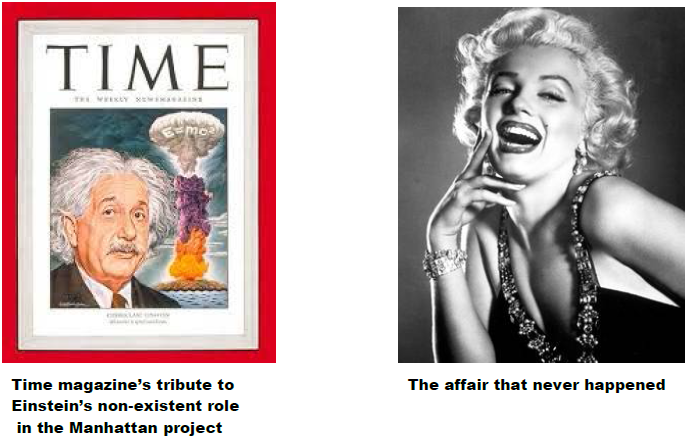 |
||
On the other hand, Einstein did have an affair, apparently lasting through the war, with Margarita Konenkova, wife of the famous Soviet sculptor Sergei Konenkov (who was responsible for the famous bronze bust of Einstein in Princeton). Konenkova was almost certainly a Soviet spy; but incredibly, the FBI was completely unaware of their relationship (which came to light in 1988, with the auction of some of his letters to her). However, in contrast to what happened in Los Alamos (where the physicist and spy Klaus Fuchs gathered much information of interest to the Soviets) Einstein was both unwilling and unable to tell Konenkova anything of US defense work. Einstein had few illusions about the intentions of both the US and Soviet regimes, and spent much of his time after the war (when not working on his 'unified field theory') promoting world peace and attempts to control the use of atomic weapons. In 1946 he took on the position of chair of the Emergency committee of Atomic Scientists, and actively promoted ideas not so different from those of Gandhi on passive resistance to totalitarianism. He also publicly opposed McCarthyism and the cold war policies of the US. Einstein's last scientific years were spent trying to find a unified field theory for all of physics. This quest led to little in the way of useful results, and in hindsight it is clear that it was very premature. Ironically, recent years in physics have seen very strenuous attempts to find such a theory, by combining quantum field theory and General Relativity in some "Theory of Everything" (often called the "TOE"). All such attempts have so far failed, primarily because it has proved impossible to join two such different theoretical frameworks. This has, for a long time, been seen as the most important problem in physics. When Einstein died in 1955, his passing was noted around the world - people alive at that time would recall many years later what they were doing when they heard the news. |
||
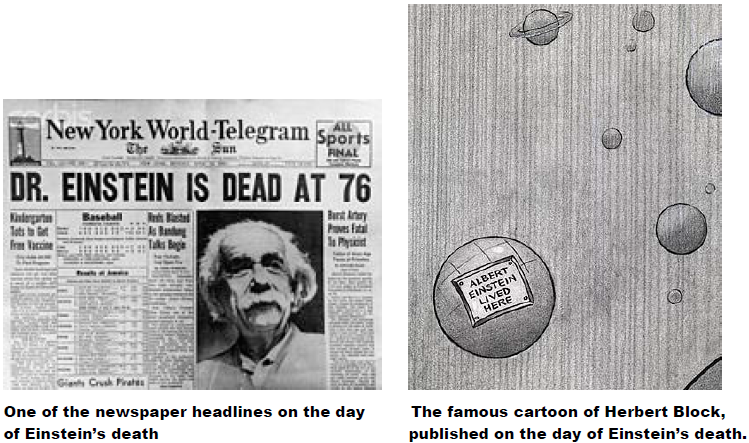 |
||
The world of today is a very different place from what it was in 1955, nearly 60 yrs ago, when Einstein died. And yet he is still lionized. This is partly for what he said about topics of interest to everyone (quotes from Einstein can be found everywhere, on almost every conceivable topic - over 90% of these quotes are fakes, often expressing views very different from the ones that Einstein actually held). It is also because his views and ideas on topics in science, philosophy, politics, and religion are to a great extent as relevant today as they were when he first formulated them. His philosophical ideas were in many ways profound (more details can be found here). He started from a view in which humans were not so different from the mammals that they had evolved from, and that our intellectual ideas rested on a non-verbal, highly intuitive basis very different from the rational foundation that is taught in most schools and universities. For Einstein religion was an understandable throwback to our primitive past, and the greatest miracle of all was that we could comprehend anything of ourselves and the universe around us. And yet nobody since Newton had used rational inquiry to understand and reveal so much about this universe. In this Einstein and Newton were very similar - both had a fundamentally mystical viewpoint, and yet both had 'faith in reason' as a way of proceeding. It is perhaps this that continues to make Einstein so fascinating to the modern world. He was very cognizant of our limitations as unimportant beings on one of many trillions of worlds in the Milky Way, and yet had evolved a philosophy - an amalgam of mysticism and rationality - that worked spectacularly well, and which offered hope, solace and inspiration in a way totally different from either naked materialism or organized religion. He seemed to have the truth in his bones. There is however another reason for the continued fascination that we hold for Einstein. This is to be found in the ever-growing impact of his scientific work. |
||
An abandoned railway engine in the Bolivian desert, |
||
Einstein post-1955: the scientific Legacy: Einstein had a huge impact on the 2 great revolutions in physics that occurred in the early 20th century. He and Planck initiated the quantum revolution, and the development of special and general relativity was uniquely his. These two theories have decisively changed not only our understanding of the universe, but also our whole lifestyle - the quantum revolution is behind everything from modern computers to the components of your car. But in what ways does Einstein's way if thinking still influence us? Gravity and the Universe: As discussed in more detail in other notes on this website, the General Theory of Relativity has, since Einstein died, has had a quite enormous impact on the evolution of physics, notably on astronomy and cosmology. The 'principle of relativity', which lies at the base of the Special Theory of Relativity (and involves, amongst other things, the constancy of the velocity of light) is one of the most secure parts of physics, along with things like the 2nd law of thermodynamics. The generalization to encompass gravity and curved spacetime, along with elements like the principle of equivalence, have led to predictions that even Einstein found hard to believe - notably the existence of 'spacetime singularities' (which include not only black holes but also the Big Bang itself). |
||
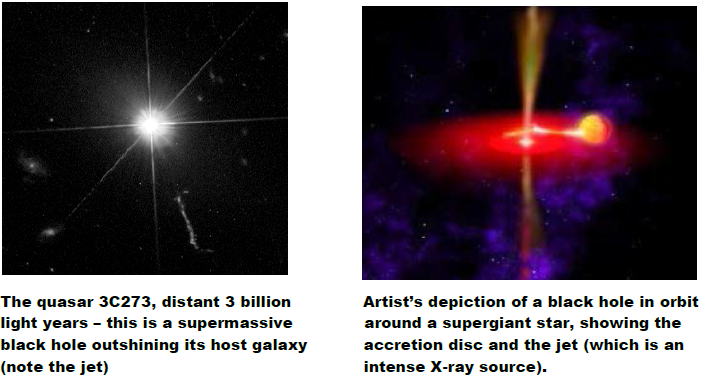 |
||
In 1955 the experimental and observational evidence for the phenomena predicted by the General Theory was very slim indeed, limited to just a few tests of very small effects prevailing in the rather weak gravitational fields in the solar system and around ordinary stars, and the observations of Hubble expansion of the universe. However beginning in the 1960's, physicists began to look much more seriously at the consequences of the theory, realizing just how peculiar its predictions were. At the same time astronomical discoveries of quasars, pulsars, and X-ray emitters began to make it clear that there exist all around us incredibly violent processes which play a key role in the heavens, and which require the full apparatus of General Relativity for their explanation. The General Theory is unquestionably Einstein's greatest work - he knew it immediately, and eventually this became clear to everyone. It stands alone with Newton's work as the pinnacle of what is possible in science. Here is a sampling of the views of some physicists on this theory: "the greatest ever feat of human thinking about Nature" (M. Born, 1918) "The theory of relativity by Einstein... cannot but be regarded as a magnificent work of art." (E Rutherford, 1920's) "probably the greatest scientific discovery ever made" (P.A.M. Dirac, 1950's) "a superhumanly keen intuition...I have no idea how he guessed at the final result....I feel as though he had done it while swimming underwater, blindfolded, and with his hands tied behind his back!" (R.P. Feynman, 1965) There is no question that we have yet to see the full consequences of the theory - already what has been found is so strange that it confounded even Einstein (who was never able to reconcile himself to the idea of black holes). It is likely that it will take us several centuries to fully unravel its consequences and predictions - form this standpoint we can see that this part of Einstein's legacy is still to be revealed to us. Quantum Mechanics: At the same time as General Relativity was being developed, the other great theory of physics, quantum mechanics, was being developed by Einstein and others. The idea of an irreducible 'quantum' of energy as first discussed by Planck in 1900, in an effort to understand problems in thermodynamics. But it was not until Einstein proposed in 1905 that light could come in discrete energy packets (what later came to be called the 'photon'), that the fully revolutionary impact of Planck's idea became clear. Before anyone else, Einstein saw the revolutionary implications of the idea that Nature had a fundamental randomness to its workings, and in the years from 1905-25 he made many key contributions to its development. And yet when quantum mechanics was finally formulated by Heisenberg and Schrodinger in 1925-26, Einstein profoundly disagreed with some of its implications. Perhaps the most extraordinary feature of Quantum Mechanics, the idea of 'entanglement' between distant objects, was first pinpointed by Einstein in 1935 in the EPR paradox, and further highlighted by Schrodinger in his "Cat" paradox. This is now understood to be one of the central features of quantum mechanics, and its full peculiarity can be illustrated by considering the 'superposition of states' shown in the diagram below. Consider again the photon - it can exist in a 'right-spinning (called a 'positive helicity') state, but also in a left-spinning one (it is this that leads to the polarization of light, used in sunglasses). o |
||
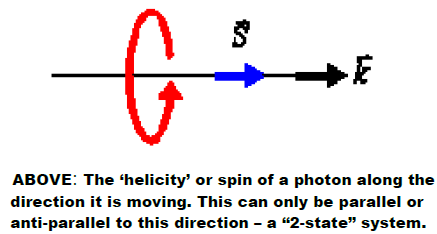 |
||
| Now in the world we are used to, the photon will be in one state OR the other. However in quantum mechanics, it can simultaneously be in both! Perhaps this does not bother you for a tiny object like a photon - but what if we were dealing with a coin? Would you be so happy to hear that it could exist simultaneously in a 'heads' state AND a 'tails' state (rather than one OR the other)? | ||
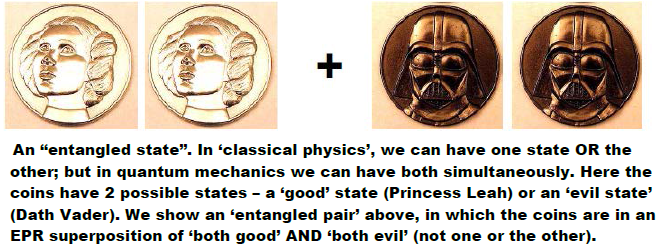 |
||
The ideas here are explained in more detail in here; but the key point is that a quantum system can indeed be in more than one state simultaneously. This is already very strange (for example, in the case of Schrodinger's cat, in a superposition of live and dead states). But as EPR pointed out, one can even have a case where one puts 2 physical systems in such a state together, as shown in the figure above, and then widely separates them - and yet they will still behave as if they are one state, even if no physical influence can pass between them. In the example of coins shown in the figure above, we on the earth could look at one of the coins and find it to be in an "evil" state, and immediately anybody looking at the other state (which could be on the moon) would find it to be 'evil' as well; but if we had NOT LOOKED, then the observer on the moon would actually find different results - even though no physical influence can pass instantaneously between us on earth and the coin on the moon! Such bizarre results have now been confirmed in experiments, but only for microscopic systems like photons or atoms. The legacy here of Einstein and Schrodinger concerns what will happen if we try to do the same for LARGE systems - like cats or people. Such superpositions and EPR states would then lead to insuperable contradictions with our own experience - and also with General Relativity. Such experiments have not been done yet, and a great deal hinges on what might happen in them. What is so disturbing here is that both General Relativity and Quantum Mechanics have shown themselves to be enormously powerful theories, each of which has transformed, like a magic wand, everything that has it has touched. Despite huge efforts to test them in different circumstances, neither has ever failed. Never before in human history have we been given such powerful ideas. And yet they are in fundamental disagreement with each other! Thus we see that Einstein's legacy includes 2 theories, both of enormous power, and forming the basis of all of modern science. Neither of them has been falsified - and yet they contradict each other. What will happen when they are finally forced to confront each other? The verdict is still open.
|
||
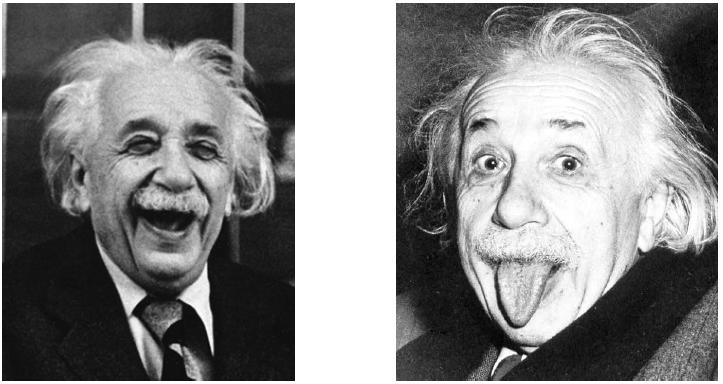 |
||
| And what would Einstein have thought of all of this? Well, we will never know, but it seems likely that he would have been amused that we will still confused by the same thing he was. And that perhaps he would after all have the last laugh. | ||
|
||

